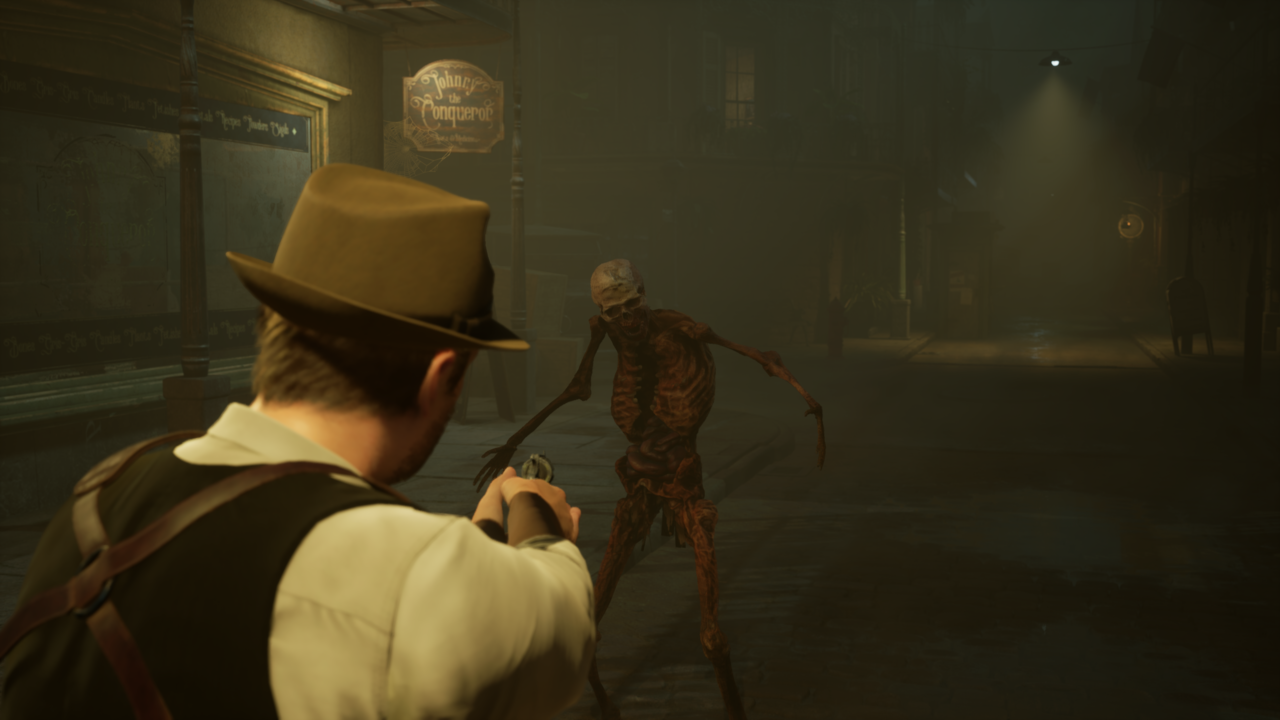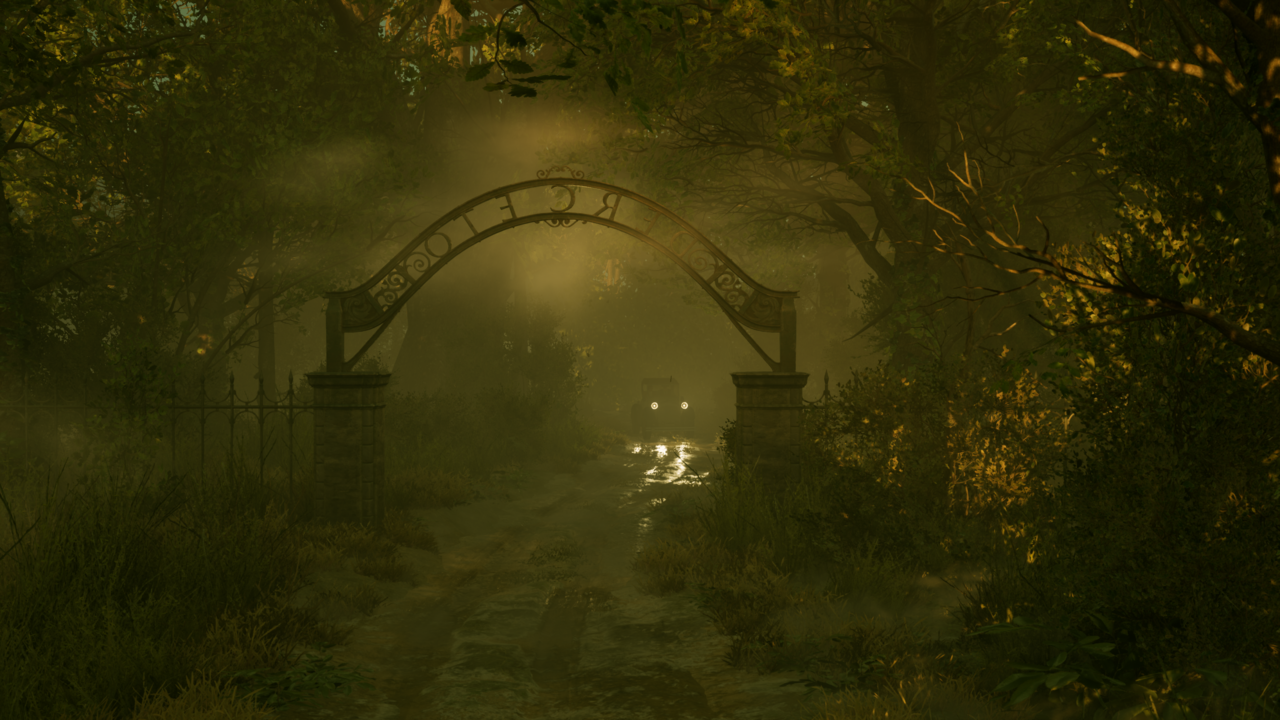When I think of the survival-horror genre’s best games, I often wonder if they were made better by their frequently unwieldy combat mechanics. The inability to reliably defend yourself heightened the terror in anti-power fantasies like Silent Hill, and the awkwardness of taking on the undead in Resident Evil became core to its tension. With that in mind, could a modern horror game benefit from having similarly janky self-defense systems? Alone in the Dark, the 2024 reboot project from THQ Nordic and Pieces Interactive, emphatically resolves this question for me; as it turns out, the answer is no--it's certainly worse off.
Alone in the Dark centers on characters and a haunted house all named the same as they were in the original 1992 game, but it mostly ditches that game's original story and old-school adventure game leanings in favor of a third-person, over-the-shoulder horror experience in line with modern counterparts. The game's writing pedigree flaunts Soma and Amnesia: The Dark Descent's Mikael Hedberg, and the story even plays out like an Amnesia game at times, to its credit. Much of what it does well is also derivative, but a larger issue is that it can’t do these aspects of the game well consistently. And all the while its worst parts are ceaselessly unenjoyable.
Chief among the blemishes is the aforementioned shoddy combat. There are three guns in total, and though wielding them feels cumbersome in the way a horror game wants to, so much else about dispatching monsters in the Derceto mansion’s hallways and bedrooms is a chore. Many enemies feel uniform in their behaviors and are often comically unaware or incapable of reaching you due to getting stuck on geometry or even each other when they show up in groups.
Even the few that do behave differently, like a monster that lurks on all fours and pounces or flying bug-like creatures that swarm down onto you, are so easily killed off that I quickly felt like the game might've been more enjoyable if there weren't any combat at all.
Melee combat feels worse than gunplay, with a swinging mechanic that behaves more like a directionless flail. I found that for best results I had to button-mash the melee weapon and just hope that I took down the enemy I was targeting before they got to me first, and I wasn't always successful.
But neither guns nor melee can outdo the confounding use of throwable weapons. Scattered around environments are bottles and Molotovs that can be thrown at the many monsters in your path. But you can't add them to your inventory: You have to throw them from where you find them, and the game's way of telling you this is to prompt you to pick one up (RT/R2) and watch as your character immediately tosses it without a care. That teaches you that the next time you want to use one, you should instead hold the button down, thereby allowing yourself to aim the throw. But you still aren't meant to actually move with the object in your hand, and if you try, the character will slowly walk in the direction you point, all while the throwing arc still sits on your screen. It's easily one of the most undercooked combat mechanics I can recall in a horror game.

It's also odd and distracting how the first shot of any round of gunfire suffers an unmissable audio delay of a second or two. Whenever I'd fire a gun, the enemy would react to the damage, and a moment later, I'd hear the gunshot. It was always the first shot and never any subsequent shots in a series of them. It didn't break the game but it was jarring for all 15 hours I played. I should mention that this occurred on Xbox for me, but not for a colleague playing on PC, though they did report other issues such as game crashes.
Alone in the Dark also features the other gameplay tentpole of the genre, as the elaborate home it takes place in is littered with puzzles. This is actually an area where the game sometimes shines, but not consistently. Some early puzzles in the mansion-turned-rest-home are fun to piece together and offer a sense of reward not just for advancing the story, but for letting you piece it together and feel like an investigator, like one of the two playable characters is.
I enjoyed exploring the mansion and opening up new avenues through which to solve its roundabout puzzles, and it was great to mix in a few otherworldly sections that pulled me out of Derceto and into various nightmarishly twisted memories. The transitions between the mansion and these other places were mostly done smoothly and caught me by surprise, albeit not without an occasional stutter, but I never found this as distracting as the gunfire audio delay.
But other puzzles were obnoxiously obtuse, with solutions that didn't feel like they were available in the game's context clues. Many of these revolve around determining safe codes or piecing broken objects back together. In one example, I had to infer a three-digit code from a letter I'd found, and the eventual solution didn't feel logically telegraphed. Alone in the Dark is sometimes more of a headache than it needs to be.
Thankfully, the doom jazz soundtrack is a nice cure for what ails you. I loved the game's atmosphere, strongly aided by the great music and good performances by Jodie Comer (Killing Eve) and David Harbour (Stranger Things). Ultimately, however, I never felt like the familiar faces from Hollywood raised the game's quality level to a degree that justifies their inclusion beyond the marketability of star power. They aren't bad in their roles by any means, but I didn't feel like they brought an element to the game that couldn't have been granted by other talented folks, making their involvement feel like simple stunt casting.

You can choose either character--Comer's Emily Hartwood or Harbour's Detective Carnby--and play the full campaign as either. For large swaths of the story, these campaigns are the same, but they each involve gameplay and story moments unique to them, like puzzle sections and some hauntings unique to each of their backstories, along with a true ending for players who finish both versions. These alternate pathways feel like a fun added wrinkle to the full story, but the allure of playing the game a second time is dampened by its issues. I liked the game's story for the most part, but I did witness a jarring sequence near the end where it so plainly and brazenly pulls a plot detail from another major horror game that I found it hard to imagine how it got through editing. You can't just repeat another game's twist, can you? Alone in the Dark suggests you can.
I found that to be such a perplexing choice, given how much else Hedberg has done well in the horror world and even does well here. Whenever the combat bored me or the puzzles left me totally stumped, I persevered, in part, because I wanted to see how the story shook out.
Led by the game's mysterious Dark Man, an entity resembling a Pharaoh, Alone in the Dark mixes in the same kind of ancient history element that the Amnesia series has done so well. It initially feels so out-of-place that it actually serves the game better in the end. You think you're getting a period-piece haunted house story, and suddenly the game is making nods to much greater supernatural oddities and blending reality and fiction in ways that make it hard to trust anything you're seeing. It makes the world of Alone in the Dark feel more uncertain, and thus, less safe. Save for the story beat that feels too close to another game's big moment, I found the story to be Alone in the Dark's best, most consistent quality.
With its reality-bending story, parade of puzzles, and unwieldy combat, Alone in the Dark is, in some ways, more faithful to some turn-of-the-century horror games than their own revitalized modern remakes. I enjoyed the game's story, setting, and abundant lore, and I felt smart when I'd overcome some of its puzzles. But others proved so obtuse as to be frustrating, and nothing about the combat even climbs to a level I'd call serviceable--it's consistently poor. This isn't Alone in the Dark's first revival attempt, and it's probably not its last, but it isn't the one that will put the series' name in the same breath as the all-time greats it originally helped inspire.